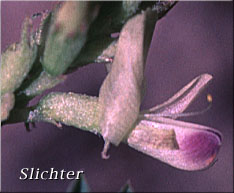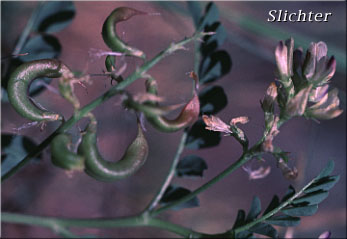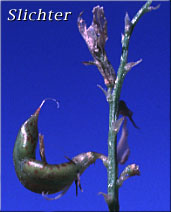
[Milkvetches: The Genus Astragalus East of the Cascade Mountains of Oregon and Washington]

 The
photo at right shows the C-shaped pods of Humboldt River milk-vetch as seen from
Willow Creek, Trout Creek Mts......June 26, 1999. Note how different the pods
shown below are.
The
photo at right shows the C-shaped pods of Humboldt River milk-vetch as seen from
Willow Creek, Trout Creek Mts......June 26, 1999. Note how different the pods
shown below are.
Humboldt River milk-vetch is a slender, spreading perennial, from 0.5-3.5 dm tall. The leaves vary from 3-7 cm in length, with 9-21 leaflets. Individual leaflets are often widespread on the leaf. Individual leaflets are broadly obovate, oblong, or oblanceolate-elliptic, and range from 5-18 mm in length.
The racemes are loosely flowered, with from 7-20 cream-colored (variety diaphanus) or reddish-purple (variety iodanthus) flowers, often with a purple spot on the tip of the keel. The banner varies from 7.5-15 mm long wile the keel is 7.5-12 mm long. The keel is longer than the wing petals in the former variety, while the keel is shorter than the wing petals in the latter variety.
The pods are either slightly declined to spreading. They have a rounded base, tapering to a sharp tip. Pods are also incurved, from moderately to strongly, so the shape as seen from the side may vary from C-shaped to almost O-shaped. At first glance, the pods look similar to those of Sickle-pod Milk-vetch (Astragalus curvicarpus), but this latter milk-vetch has pods that are thin in cross-section, while the pods of Humboldt River milk-vetch are thicker in cross-section.
 Varieties
of Humboldt River Milk-vetch:
Varieties
of Humboldt River Milk-vetch:
var. diaphanoides: Petals whitish-yellow or creamy and lilac tinged, especially at the tips. The keel is less than 2 mm shorter than the banner, which is less than 11 mm long. In addition, the wings are shorter than the keel. The calyx is typically longer than 3.5 mm long. Found in Oregon in southern Harney and Malheur Counties.
var. iodanthus: Petals often bright purple drying violet. The keel is at least 2 mm shorter than the banner which is at least 11 mm long. The keel is also shorter than the wings. The calyx is typically less than 3.5 mm long. In Oregon, it is found only in the Trout Creek Mts.
Humboldt River milk-vetch is found at low to mid-elevation in gullies, valley floors, washes, outwash fans, and occasionally on the hillsides and bluffs surrounding river floodplains.
Humboldt River milk-vetch is found from southeastern Oregon south to east-central California and northern and central Nevada.